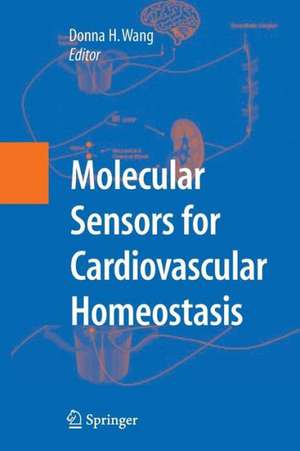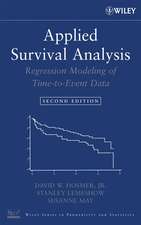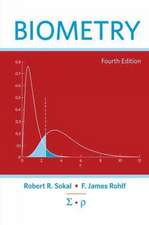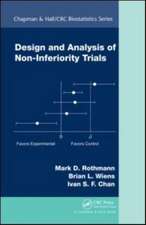Molecular Sensors for Cardiovascular Homeostasis
Editat de D.H. Wangen Limba Engleză Paperback – 15 sep 2014
| Toate formatele și edițiile | Preț | Express |
|---|---|---|
| Paperback (1) | 1090.61 lei 6-8 săpt. | |
| Springer Us – 15 sep 2014 | 1090.61 lei 6-8 săpt. | |
| Hardback (1) | 983.03 lei 38-44 zile | |
| Springer Us – 14 mai 2007 | 983.03 lei 38-44 zile |
Preț: 1090.61 lei
Preț vechi: 1148.02 lei
-5% Nou
Puncte Express: 1636
Preț estimativ în valută:
208.68€ • 217.88$ • 172.72£
208.68€ • 217.88$ • 172.72£
Carte tipărită la comandă
Livrare economică 05-19 aprilie
Preluare comenzi: 021 569.72.76
Specificații
ISBN-13: 9781489991997
ISBN-10: 1489991999
Pagini: 228
Ilustrații: VIII, 212 p.
Dimensiuni: 155 x 235 x 12 mm
Greutate: 0.33 kg
Ediția:2007
Editura: Springer Us
Colecția Springer
Locul publicării:New York, NY, United States
ISBN-10: 1489991999
Pagini: 228
Ilustrații: VIII, 212 p.
Dimensiuni: 155 x 235 x 12 mm
Greutate: 0.33 kg
Ediția:2007
Editura: Springer Us
Colecția Springer
Locul publicării:New York, NY, United States
Public țintă
ResearchDescriere
Biological homeostasis is maintained via intact function of an array of molecules detecting changes of microenvironments inside and outside of the biological system. These molecules, including cell membrane proteins and ion channels, are intimately involved in a variety of sensory pathways and respond to environmental stimuli, including altered temperature, pH, mechanical and osmotic stress, intra- and extracellular messengers, as well as changes in energy consumption. The book reveals the state-of-the-science of several newly discovered ion channel families and their role in the pathogenesis of cardiovascular diseases. This work offers comprehensive and up-to-date information for a deeper understanding of the relationship between macro- and micro-environments, ion channels, and pathophysiological responses, and for developing novel therapies for treating devastating cardiovascular illnesses.
Cuprins
The DEG/ENaC Family.- The Role of DEG/ENaC Ion Channels in Sensory Mechanotransduction.- ASICs Function as Cardiac Lactic Acid Sensors During Myocardial Ischemia.- Molecular Components of Neural Sensory Transduction.- The TRP Family.- TRP Channels as Molecular Sensors of Physical Stimuli in the Cardiovascular System.- TRPV1 in Central Cardiovascular Control.- TRPV1 as a Molecular Transducer for Salt and Water Homeostasis.- Functional Interaction Between ATP and TRPV1 Receptors.- TRPV4 and Hypotonic Stress.- Other Ion Channels and Biosensors.- Ion Channels in Shear Stress Sensing in Vascular Endothelium.- Redox Signaling in Oxygen Sensing by Vessels.- Impedance Spectroscopy and Quartz Crystal Microbalance.
Textul de pe ultima copertă
Molecular Sensors for Cardiovascular Homeostasis
Donna H. Wang, MD, FAHA, FAAN
Biological homeostasis is maintained via intact function of an array of molecules detecting changes of microenvironments inside and outside of the biological system. These molecules including cell membrane proteins and ion channels are intimately involved in a variety of sensory pathways and respond to environmental stimuli, including altered temperature, pH, mechanical and osmotic stress, intra- and extracellular messengers, as well as changes in energy consumption. All of these modalities are involved in systemic, cellular, and molecular regulation. A better understanding of the structural, functional, and physiological properties of these proteins/ion channels would provide insight into mechanisms underlying disease processes, as well as facilitate fabrication of precisely defined, nanostructured interfacial architectures or molecular electronics that express and measure the activities of these proteins/channels.
Molecular Sensors for Cardiovascular Homeostasis reveals state-of-the-science of several newly discovered ion channel families and their role in the pathogenesis of cardiovascular diseases. This work offers comprehensive and up-to-date information for a deeper understanding of the relationship between macro- and micro-environments, ion channels, and pathophysiological responses, and for developing novel therapies for treating devastating cardiovascular illnesses.
Molecular Sensors for Cardiovascular Homeostasis is essential reading for neuroscientists, molecular biologists, cardiovascular researchers, electrophysiologists, cardiologists, pathologists, neurosurgeons, and researchers and students interested in biomedical engineering, nanotechnology, and design and development of medical devices.
Key Topics:
Dr. Donna H. Wang is a Professor in the Department of Medicine, Neuroscience Program, and Cell & Molecular Biology Program at Michigan State University. She also serves as the Director of Investigative Medicine and the Vice Chair for Basic Research for the Department of Medicine. Dr. Wang is an Established Investigator of the American Heart Association, a Fellow of the American Heart Association Council for High Blood Pressure Research, a Fellow of Cardiovascular Section of the American Physiological Society, and a Fellow of the American Academy of Nanomedicine. She serves on many national and international scientific and policy review panels and committees, including US National Institutes of Health, American Heart Association, and the Wellcome Trust of UK.
Donna H. Wang, MD, FAHA, FAAN
Biological homeostasis is maintained via intact function of an array of molecules detecting changes of microenvironments inside and outside of the biological system. These molecules including cell membrane proteins and ion channels are intimately involved in a variety of sensory pathways and respond to environmental stimuli, including altered temperature, pH, mechanical and osmotic stress, intra- and extracellular messengers, as well as changes in energy consumption. All of these modalities are involved in systemic, cellular, and molecular regulation. A better understanding of the structural, functional, and physiological properties of these proteins/ion channels would provide insight into mechanisms underlying disease processes, as well as facilitate fabrication of precisely defined, nanostructured interfacial architectures or molecular electronics that express and measure the activities of these proteins/channels.
Molecular Sensors for Cardiovascular Homeostasis reveals state-of-the-science of several newly discovered ion channel families and their role in the pathogenesis of cardiovascular diseases. This work offers comprehensive and up-to-date information for a deeper understanding of the relationship between macro- and micro-environments, ion channels, and pathophysiological responses, and for developing novel therapies for treating devastating cardiovascular illnesses.
Molecular Sensors for Cardiovascular Homeostasis is essential reading for neuroscientists, molecular biologists, cardiovascular researchers, electrophysiologists, cardiologists, pathologists, neurosurgeons, and researchers and students interested in biomedical engineering, nanotechnology, and design and development of medical devices.
Key Topics:
- Degenerin Ion Channel Family
- Transient Receptor Potential Ion Channel Family
- Ion Channels in Mechanotransduction
- Redox Signaling in Oxygen Sensing
- Molecular Electronics as Biosensors
- Neural Sensory Transduction
- Baro- and Chemo-Receptors
- Cardiac lactic Acid Sensors
- Central Cardiovascular Control
- Salt and Water Homeostasis
- Osmotic Sensing
- Ligand-Receptor Interfacing
Dr. Donna H. Wang is a Professor in the Department of Medicine, Neuroscience Program, and Cell & Molecular Biology Program at Michigan State University. She also serves as the Director of Investigative Medicine and the Vice Chair for Basic Research for the Department of Medicine. Dr. Wang is an Established Investigator of the American Heart Association, a Fellow of the American Heart Association Council for High Blood Pressure Research, a Fellow of Cardiovascular Section of the American Physiological Society, and a Fellow of the American Academy of Nanomedicine. She serves on many national and international scientific and policy review panels and committees, including US National Institutes of Health, American Heart Association, and the Wellcome Trust of UK.
Caracteristici
This title will attract a vast range of readers including scientists and investigators in both academic and industrial fields and clinicians
Graduate students will also be interested in buying this book, particularly as there is exponential growth of courses on this subject
Graduate students will also be interested in buying this book, particularly as there is exponential growth of courses on this subject










